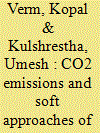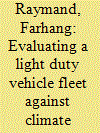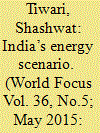|
|
|
Sort Order |
|
|
|
Items / Page
|
|
|
|
|
|
|
| Srl | Item |
| 1 |
ID:
141238


|
|
|
|
|
| Summary/Abstract |
During the last five years, India has achieved to become world’s ninth largest economy with a real GDP growth of 8.7% which is exceptional evidence of the growth of Indian economy [Energy Statistics, 2013]. Such a high economic growth involves enormous pressure on the energy resources of the country resulting in increased demand and supply imbalance across all energy sources. India’s energy basket has mixture of all the resources with the dominance of coal [Energy Statistics, 2013]. Being the capital of India, Delhi is the hub of opportunities for all including youth, entrepreneurs, governments, and the directly or indirectly associated people. This catalyses the processes of migration which is responsible for the growth of population, size of the urban area and industrialization [Aggarwal and Jain, 2014]. This further leads towards increased energy consumption posing serious environmental and human health threats. The worsening air quality of the city is triggering various respiratory problems such as chronic bronchitis, lung cancer and infections etc. Adverse air quality also affects visibility and climate, most of the time making irreversible changes. One such example is climate change which is difficult to cope by `hard’ mitigating methods due to human desires and geographical competitiveness for modern development. Due to these reasons many people believe that our climatic conditions will never be restored into the original form and adaptation is the only option for future generation. However, it is possible to reduce greenhouse gases (GHG) and carbon emissions by `soft’ techniques. Taking into account the consumption of fossil fuels by different sources and their emissions in Delhi National Capital Region (NCR), this article focuses upon the soft approaches to mitigate (GHG) and carbon emissions.
|
|
|
|
|
|
|
|
|
|
|
|
|
|
|
|
| 2 |
ID:
132908


|
|
|
|
|
| Publication |
2014.
|
| Summary/Abstract |
Promotion of renewable energy and application of clean technology are essential for limiting emissions of GHG and facilitating environmentally compatible development. Although India and the European Union (EU) recognise their vulnerability to climate change, they differ on their 'normative claims' of the global climate change regime. India and the EU do not agree on emission cut targets. They can cooperate in multiple ways in the areas of clean technologies, renewable energy, research and development and sharing knowledge for sustainable development planning, etc. India has adopted a comprehensive National Action Plan on Climate Change (NAPCC), which comprises of both mitigation and adaptation measures to climate change. The implementation of the NPACC would be crucial in shaping a policy for inclusive and sustainable development. Hence, cooperation between India and the EU can take place in areas of the NAPCC that would help not only in coping with climate change, but also in enhancing India's economic relations as well as development partnership with the EU.
|
|
|
|
|
|
|
|
|
|
|
|
|
|
|
|
| 3 |
ID:
177367


|
|
|
|
|
| Summary/Abstract |
Transportation sector makes up a big share of every country's greenhouse gas (GHG) emissions. The light duty vehicle (LDV) sub-sector, in particular, has experienced a substantial growth in recent years without showing signs of slowing down. Regulations coupled with incentives that make alternate-powertrain vehicles more attractive financially, have become a key policy to keep emissions from this sector in check.
|
|
|
|
|
|
|
|
|
|
|
|
|
|
|
|
| 4 |
ID:
107500


|
|
|
|
|
| Publication |
2011.
|
| Summary/Abstract |
Greenhouse gas (GHG) emissions from reservoirs have been under the microscope for more a decade now. In particular, the high CH4 emissions reported in warm systems have tarnished the green credentials of hydroelectricity in terms of GHG emissions. Reliable estimates of CH4 emissions are crucial, since CH4 has a greenhouse warming potential of 25 and because, unlike CO2, CH4 emissions should be counted for the entire life cycle of a reservoir. Up to now, the highest CH4 emissions from reservoirs have been measured in warm latitudes, thus adding an argument against the use of hydroelectricity in these regions. However, to our knowledge, GHG emissions have been measured for only 18 of the 741 large dams (>10 MW, according to the ICOLD register) listed in the tropics. This article reviews the limited scientific information available and concludes that, at this time, no global position can be taken regarding the importance and extent of GHG emissions in warm latitudes.
|
|
|
|
|
|
|
|
|
|
|
|
|
|
|
|
| 5 |
ID:
092847


|
|
|
|
|
| Publication |
2009.
|
| Summary/Abstract |
An effective consumer-oriented climate policy requires knowing the GHG reduction potential of sustainable consumption. The aim of this study is to draw lessons from differences in consumption between households with high and low GHG emissions. We evaluate a survey of 14,500 households and use a method that allows measuring changes in price level of consumption. Comparing the 10% of households with the highest GHG emissions per capita with the lowest 10% - controlling for differences in expenditure level and household structure - we find a range 5-17 tons of CO2-equivalent per capita and year. The observed differences stem mainly from heating, electricity use, car use, and travel by aircraft. Consumption patterns with low GHG emissions are characterized by less spending on mobility, but more on leisure and quality oriented consumption (leading to higher prices per unit). Further characteristics are: a higher share of organic food, low meat consumption and fewer detached single family houses. Our findings imply that a significant reduction in GHG emissions would be possible by adopting real-world consumption patterns observable in society. The twin challenge is to shift consumption towards more climate friendly patterns, and to prevent any trend towards high emitting consumption patterns.
|
|
|
|
|
|
|
|
|
|
|
|
|
|
|
|
| 6 |
ID:
138389


|
|
|
|
|
| Summary/Abstract |
Energy security shall remain an inter-play of demand and supply scenarios, which in themselves are influenced by a number of factors which need careful evaluation and consideration over the long-term. India has presence of dynamic private sector and a burgeoning middle class, however it faces growing challenges to maintain its economic growth. In the first quarter of 2012, the Indian economy grew by 5.3 per cent, which is the lowest in the past ten years. With increase in trade and budget deficits, there are challenges associated with a depreciating currency. To continue with the economic growth an accelerated transition to an energy sector based on market economy is the call of the hour.
|
|
|
|
|
|
|
|
|
|
|
|
|
|
|
|
| 7 |
ID:
133017


|
|
|
|
|
| Summary/Abstract |
The identification of the main sources of anthropic greenhouse gas emissions (GHG) associated with the mitigation and removal of these emissions has become an important instrument in the attenuation of the climatic changes predicted by the IPCC. The largest emission source in Brazil is forest conversion. This land use change has always had a strong relationship with the expansion of agriculture, an activity of great importance in the country, which has the largest commercial cattle herd in the planet. Following the considerable reduction in emissions from deforestation, agriculture has been since 2010 the most important source (MCTI (Ministério da Ciência, Tecnologia e Inovação), 2013. Brasília: Ministério daCiência, Tecnologia e Inovação, Brasil). Seeking to discover the possibilities of altering the emissions profile in the agricultural sector, four scenarios were developed related to how this is dealt with in the beef cattle sector, calculating the potential removal of carbon from the atmosphere through natural regeneration of biomes. The results suggest that picketing and rotation scenario has the greatest potential, with a carbon reduction of 17.7 Gt CO2eq, while the shared raising with grain legumes scenario has the lowest calculated reduction potential of 7.1 Gt CO2eq was calculated. The animal confinement scenario had an intermediary reduction potential of 8.3 Gt CO2eq. The mosaic of methods scenario, in which it is attempted to simulate the parallel adoption of the measures proposed in all other scenarios, had a reduction potential of 13.1 Gt CO2eq. In the scenarios where animal confinement occurs, the treatment of waste with biodigestion allows the generation of biogas and biofertilizers, contributing to an increase in the potential carbon reduction.
|
|
|
|
|
|
|
|
|
|
|
|
|
|
|
|
| 8 |
ID:
126840


|
|
|
|
|
| Publication |
2014.
|
| Summary/Abstract |
This paper's purpose is to investigate the role of sea ports in helping to mitigate the GHG emissions associated with the end-to-end maritime transport chain. The analysis is primarily focused on the UK, but is international in application. The paper is based on both the analysis of secondary data and information on actions taken by ports to reduce their emissions, with the latter data collected for the main UK ports via their published reports and/or via interviews. Only a small number of ports (representing 32% of UK port activity) actually measure and report their carbon emissions in the UK context. The emissions generated by ships calling at these ports are analysed using a method based on Department for Transport Maritime Statistics Data. In addition, a case example (Felixstowe) of emissions associated with HGV movements to and from ports is presented, and data on vessel emissions at berth are also considered.
Our analyses indicate that emissions generated by ships during their voyages between ports are of a far greater magnitude than those generated by the port activities. Thus while reducing the ports' own emissions is worthwhile, the results suggest that ports might have more impact through focusing their efforts on reducing shipping emissions.
|
|
|
|
|
|
|
|
|
|
|
|
|
|
|
|
|
|
|
|
|